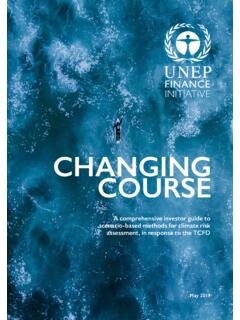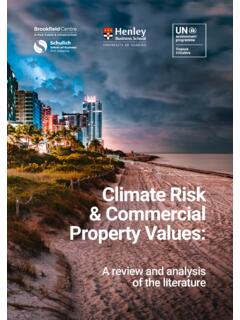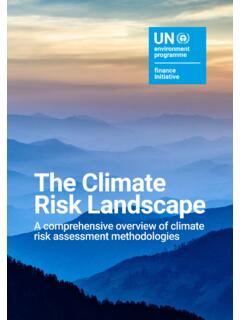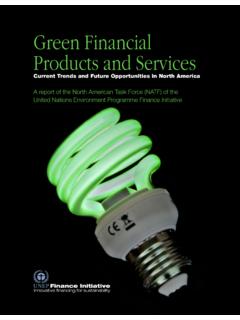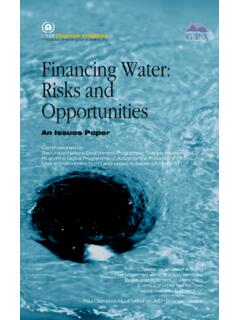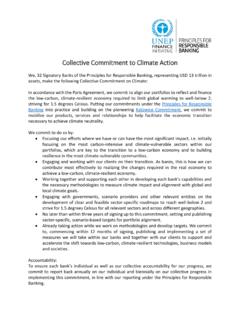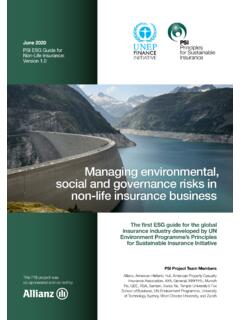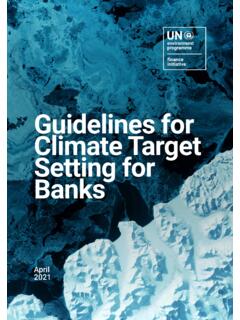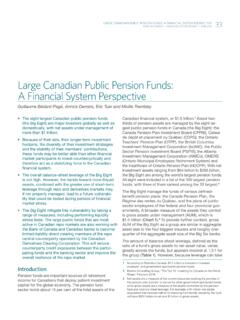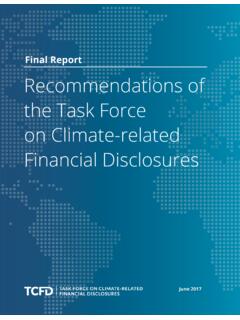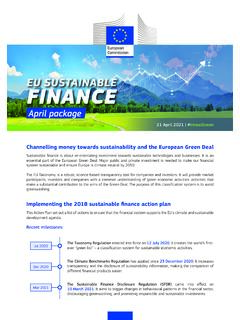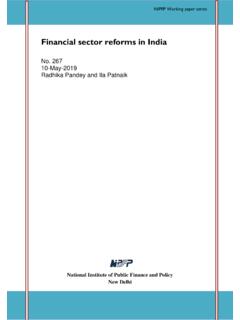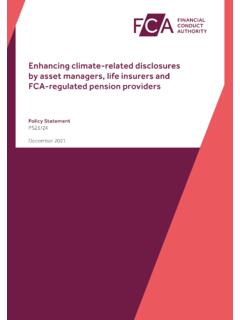Transcription of Financial institutions taking action on climate change
1 Developed by the following groups Institutional Investors Group on climate change Financial institutions . taking action ON. climate change . A report on how climate leadership is emerging in the finance sector - and on how public and private actors need to work together to grow leadership into a new normal UNEP. Acknowledgements This report Financial institutions taking action on climate change would not have been possible without the support of the World Bank Group and the United Nations Environment Programme. The findings, interpretations, views, and conclusions expressed herein are those of the authors and do not necessarily reflect the views of the Executive Directors of the International Finance Corporation or of the International Bank for Reconstruction and Development (the World Bank) or the governments they represent. This report would not have been possible without the contribution of case studies by numerous Financial institutions .
2 Unfortunately it has not been possible to identify every instance of leadership in this report. We also acknowledge the work of Dr Danyelle Guyatt for her invaluable contribution in the drafting of this document. About the World Bank Group About the United Nations Environment Programme The World Bank Group is one of the world's largest sources of funding United Nations Environment Programme, established in 1972, is the voice and knowledge for developing countries. It comprises five closely for the environment within the United Nations system. UNEP acts as a associated institutions : the International Bank for Reconstruction and catalyst, advocate, educator and facilitator to promote the wise use and Development (IBRD) and the International Development Association sustainable development of the global environment. The UNEP Finance (IDA), which together form the World Bank; the International Finance Initiative (UNEP FI) is a global partnership between UNEP and the Corporation (IFC); the Multilateral Investment Guarantee Agency (MIGA); Financial sector.
3 Over 230 institutions , including banks, insurers and fund and the International Centre for Settlement of Investment Disputes managers, work with UNEP to understand the impacts of environmental (ICSID). Each institution plays a distinct role in the mission to fight poverty and social considerations on Financial performance. UNEP FI's member- and improve living standards for people in the developing world. For ship consists of private and public Financial institutions from around the more information, please visit , , and world and is balanced between developed and developing countries. For more information, please visit and ABOUT AIGCC ABOUT INCR. The Asia Investor Group on climate change (AIGCC) is an initiative set up by the The Investor Network on climate Risk (INCR) is a North America-focused network Association for Sustainable and Responsible Investment in Asia (ASrIA) to create of institutional investors dedicated to addressing the Financial risks and invest- awareness among Asia's asset owners and Financial institutions about the risks ment opportunities posed by climate change and other sustainability challenges.
4 And opportunities associated with climate change and low carbon investing. AIG- INCR currently has more than 100 members representing over $13 trillion in as- CC provides capacity for investors to share best practice and to collaborate on in- sets. INCR is a project of Ceres, a nonprofit advocate for sustainability leadership vestment activity, credit analysis, risk management, engagement and policy. With that mobilises investors, companies and public interest groups to accelerate and a strong international profile and significant network, including pension, sovereign expand the adoption of sustainable business practices and solutions to build a wealth funds insurance companies and fund managers, AIGCC represents the healthy global economy. Visit Asian voice in the evolving global discussions on climate change and the transition to a greener economy. Visit ABOUT PRI. The United Nations-supported Principles for Responsible Investment (PRI).
5 ABOUT IGCC Initiative is an international network of investors working together to put the six Principles for Responsible Investment into practice. Its goal is to understand the IGCC is a collaboration of 52 Australian and New Zealand institutional investors implications of Environmental, Social and Governance issues (ESG) for investors and advisors, managing approximately $1 trillion and focussing on the impact and support signatories to incorporate these issues into their investment decision that climate change has on the Financial value of investments. The IGCC aims to making and ownership practices. In implementing the Principles, signatories encourage government policies and investment practices that address the risks contribute to the development of a more sustainable global Financial system. Visit and opportunities of climate change , for the ultimate benefit of superannuants and unit holders. Visit ABOUT IIGCC ABOUT UNEP FI.
6 The Institutional Investors Group on climate change (IIGCC) is a forum for UNEP FI is a global partnership between UNEP and the Financial sector. Over 200. collaboration on climate change for investors. IIGCC's network includes over 90 institutions , including banks, insurers and fund managers, work with UNEP to members, with some of the largest pension funds and asset managers in Europe, understand the impacts of environmental and social considerations on Financial representing in assets. IIGCC's mission is to provide investors a performance. Through its climate change Advisory Group (CCAG), UNEP FI aims common voice to encourage public policies, investment practices and corporate to understand the roles, potentials and needs of the finance sector in addressing behaviour which address long-term risks and opportunities associated with climate change , and to advance the integration of climate change factors - both climate change .
7 Visit risks and opportunities into Financial decision-making. Visit Report contents 1. Key messages 4 2. The role of the finance sector in achieving a low carbon, climate resilient world 6. 3. Finance sector leadership is building momentum 8 1. Low carbon and energy efficiency finance and investing 2. Emissions reducing finance and investing 3. Adaptation finance and investing 4. Measurement and transparency 5. Engagement with companies 6. Engagement with policy makers 4. taking leadership to the next level 35. 5. Concluding thoughts 36. 3. Financial institutions taking action ON climate change . 1. Key messages There is a growing community of Financial institutions taking action and demonstrating leadership on climate change . Some institutions are allocating capital and steering Financial flows towards more low carbon, climate resilient activities. Others are taking steps to change corporate behavior, influence policy outcomes and build the data, tools and transparency required to embed climate change into how the market functions.
8 This report details finance sector leadership actions and their contribution to solving the climate change challenge across the following six areas: 1. Low carbon and energy efficiency finance and investing: Pension fund allocation to low carbon and energy efficiency: Some pension funds are increasing their allocation to low carbon and energy efficiency assets, thereby playing a vital leadership role. Supporting renewable energy projects: Some institutional investors are investing in renewable projects via private equity and infrastructure opportunities. Some banks are shifting their loan books towards financing renewables projects. These actions are having a direct impact on the availability of capital for renewable energy projects. Partnerships in developing countries: Unique partnerships are forming between governments, development banks and Financial institutions to finance and invest billions of dollars into renewable energy and energy efficiency opportunities in emerging markets.
9 Growing green bond market: A flourishing green bond market exists and is growing, which is integral to providing the debt capital needed to finance the low carbon transition. Reducing real estate emissions and energy use: The industry is utilizing new tools, setting targets and steering portfolios and financing activities towards lower carbon, higher rated energy efficient buildings, a core pillar for achieving the energy efficiency improvements needed to avoid dangerous climate outcomes. 2. Emissions reducing finance and investing: New techniques are being implemented by Financial institutions to reduce the carbon emissions of loan books and investment portfolios; an indirect but potentially powerful mechanism for reducing global emissions. In addition, new strategies and approaches are being implemented by institutional investors to manage the risks stemming from exposure to fossil fuel companies. 3. Adaptation finance and investing: Banks and insurance companies are developing financing solutions to support adaptation projects, primarily in developing countries, with significant potential for more Financial institution involvement in partnership with governments, development banks and developing country agencies.
10 4. Measurement and transparency: The industry is collaborating to improve carbon and climate change risk/performance measurement and reporting by companies and by the finance institutions themselves, a crucial building block for managing and reducing carbon emissions. 4. Financial institutions taking action ON climate change . 5. Engagement with companies: Growth in proxy voting action related to climate change as well as extensive company engagement is having a direct impact on corporate reporting of carbon emissions and strategies to respond to climate change . 6. Engagement with policy makers: The industry is collaborating to engage with policy makers to influence policy and regulatory outcomes that encourage greater participation from the finance industry in the transition to a low carbon, climate resilient economy. The formulation of international and national policy measures provide the backdrop against which some of these leadership actions have emerged.
